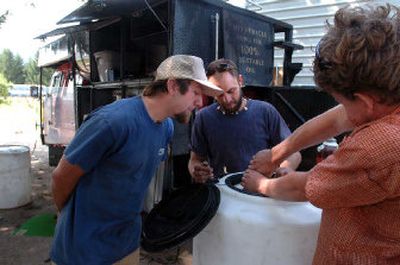Unique firetruck carries a message

It was part of a dream for Seth Warren and Tyler Bradt. The professional kayakers from Montana would time their journey from Alaska to Chile precisely, hitting perfect paddling seasons on waterways along their route.
And they’re doing it in a Japanese fire engine that runs on vegetable oil.
Warren, 29, and Bradt, 20, have spent four months on the road, starting in Dead Horse, Alaska, on that state’s northernmost road.
They have been in Sandpoint this past week refurbishing parts of their unusual red and black vehicle with Japanese lettering on the side. They are working to prepare for the nine-month road trip ahead. And while in town, they plan to give a biodiesel presentation tonight.
Eventually they hope to end up in the southernmost part of South America next spring on a journey they’ve dubbed the Oil and Water Project. Before reaching Chile, the expeditionary kayakers will meet with environmental groups and schoolchildren and talk about the use of alternative fuels. Schools throughout the Americas, like one in the Central American country of Belize, are collecting vegetable oil and seeds for them to use on their trip.
Warren and Bradt bought the diesel fire engine in Saskatchewan from someone who had imported the vehicle, hoping to sell it for firefighting use. It had just 6,000 kilometers – about 3,700 miles – on the engine; they picked it up for $6,000.
“It’s the perfect vehicle for what we wanted to do, with its beefy fire truck suspension,” Bradt said.
They also were able to convert it into a machine that hauls all of their gear and the equipment to convert raw seeds from a variety of plants into fuel.
Diesel engines, the two said, can run on vegetable and animal oils. They said they drove down from Alaska on salmon oil.
The oil simply needs to be heated to a certain point so it burns easier and does not clog the engine system. The vehicle is started with a biodiesel mixture containing ethanol, then is switched to raw oil once the liquid is fully heated.
“The idea originated through our kayaking lifestyle,” Bradt said. “We became pretty concerned with what’s happening with gas around the world.”
The bulky ride, which the two affectionately call “The Rig,” reaches a top speed of about 50 mph. The kayakers are making quite a few side trips on their transcontinental trek, including detours to whitewater rapids.
The trip also will be filmed, Warren said. During the stop in Sandpoint, a Hollywood filmmaker interested in making a documentary of their escapades met with the two.
“This is pretty much a childhood dream coming true with this trip,” Bradt said.